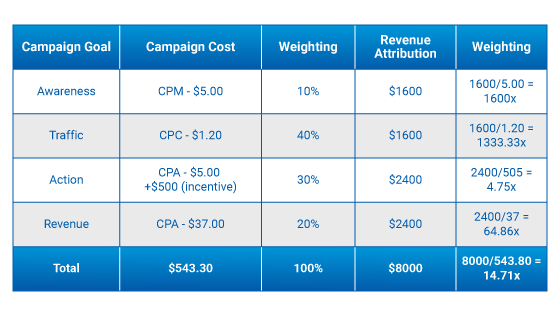When you decide you are ready for your business to grow, you need to invest in marketing. But like any investment, you need to be sure you can determine its return (ROI – Return on Investment) to hone your marketing strategy for maximum yield — so where do you start?
You probably already know that the ultimate measure of your ROI is sales or profit. However, when it comes to the campaigns your customer views en route to purchase, calculating ROI is complicated by the business goals around each one. Each touchpoint in the customer’s journey represents a different type of campaign, with different goals at every stage. All of them fall under the umbrella of growth marketing, which typically encompasses four subcategories: awareness, traffic, actions, and revenue. All four can be crucial to a successful marketing strategy, so it’s important to determine how effective your investment in each area has been.
Here’s how you should consider the ROI for each type:
1. Awareness
These are the initial ads your customer sees promoting your brand. These campaigns aren’t necessarily meant to drive sales and revenue, but rather to “warm-up” cold audiences to the brand before putting on a “hard sell.” They are an important part of the sales cycle when targeting new customers because these audiences usually need some familiarity and trust with a brand before they will transact.
Key Performance Indicators: Awareness campaign KPIs can include video views, ad impressions, and ad recall uplift. Typically, the cost is calculated per 1000 impressions (CPM), or per three- or 10-second video view. It is important to note that without third party measurement tools like Facebook’s Ads Manager it’s difficult to truly assess the ROI of awareness campaigns, because the platform serving the ads may not define its KPIs the same way you would, and thus may be inaccurate for your goals.

2. Traffic
As a next step, you should deploy traffic campaigns. After you build awareness of your brand, traffic ads are designed to bring qualified visitors to your site through multiple ad channels, including search, display, and video campaigns. The key consideration for these campaigns is the quality of the traffic coming to your site. Many platforms draw significant volumes of low-cost traffic, but focusing solely on how many visitors you attract will likely lead to a lower ROI over time, because low quality traffic is unlikely to convert to sales.
Key Performance Indicators: KPIs, such as time on page, the number of pages visited, or key pages viewed, are the keys to determining the quality of your visitors. Traffic campaigns are commonly measured on a cost per click (CPC) basis, which is the average amount you paid per click on your ad. At the ad platform level, the KPIs available are usually clicks on your ad and views of a landing page on your site. Tracking code on your site like the “Facebook Pixel” can measure the traffic from the ad platform to the landing page. From there, you should employ these additional engagement metrics to determine if you’re reaching the right audience.

3. Actions
Your next step might be getting potential customers to watch a video or engage with specific content on your website. Your goal with these action-focused campaigns is primarily to get customers to do something that further engages with or informs them about your product or service. Action campaigns focus on guiding “warmed up” users into specific actions on your website, such as watching a video, viewing a pricing page, or reading product documentation. You can track this engagement onsite through tools such as Google Analytics.
Key Performance Indicators: You can measure KPIs for action campaigns by tracking the percent increase in the desired action. For example, you might calculate the percentage increase in views of 50 percent or more of a key video or the number of signups for a newsletter. To fully assess the ROI for these campaigns, you must also assign a value to the action you want users to take. By assigning a financial value to an action, it becomes easier to measure the financial return on the investment in paid media. This could include for example, assigning a value of $50 for each successful newsletter subscriber, or $10 for every visitor that watches a key product video to 75%.

4. Revenue
When you’re finally ready to go in for the sale, you run revenue campaigns. The goal for revenue-focused campaigns is to drive previously warmed audiences to buy/convert. These ads target subsets of the entire audience that have a higher propensity to buy such as, previous purchasers, repeat visitors to a pricing page, or users with an abandoned cart, etc. An example would be a renewal campaign focused on targeting previous purchasers prior to their renewal date to drive repeat sales and loyalty.
Key Performance Indicators: The ultimate KPI for revenue campaigns is actual revenue, to this end ROI on revenue campaigns is generally tied to e-commerce platforms. KPIs for these ads are often only focused on the last-click attribution of a sale. You can measure this in ways such as ROAS (Return on Ad Spend), which attributes the sale to the last-touch converting campaign, and measures the amount spent on the campaign to the amount of revenue attributed to the campaign.

Bringing Your Metrics Together
As you think about calculating the ROI on your growth marketing investment, be sure to consider the potential conflicts in how ad platforms measure and claim ROI. For accurate calculations, it’s best to use an independent measurement of campaign and platform success. For example, you might use a CRM platform that tracks customer engagement with ads or dedicated tools like Google Analytics or Facebook Attribution.
A properly configured attribution tool will enable you to accurately track and measure the customer’s path-to-purchase. Correctly attributing successes to all channels can involve assigning proportional revenue from a transaction (or the value of an action) back to the ad channel and the related campaign type.
Let’s consider a first time customer who makes an $8,000 purchase. In the lead up to the transaction, the customer saw campaigns in all four categories of your marketing strategy.
Attribution tools can then assign a break down of proportional revenue to each platform. In this example, additional weighting is given to campaigns that first brought new customers to the site, with lesser weighting for retargeting that brought them back. So, a revenue attribution break down could look like the following:

With this information, you can strengthen your marketing strategy, honing a well-oiled sales machine. If you are interested in learning more about customized tools for tracking your growth marketing ROI, reach out to us today.



